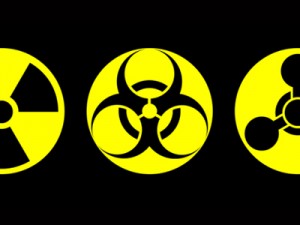 The Syrian military is prepared to use chemical weapons against its own people and is awaiting final orders from President Bashar Assad, U.S. officials told NBC News on Wednesday.
The Syrian military is prepared to use chemical weapons against its own people and is awaiting final orders from President Bashar Assad, U.S. officials told NBC News on Wednesday.
The military has loaded the precursor chemicals for sarin, a deadly nerve gas, into aerial bombs that could be dropped onto the Syrian people from dozens of fighter-bombers, the officials said.
As recently as Tuesday, officials had said there was as yet no evidence that the process of mixing the “precursor” chemicals had begun. But Wednesday, they said their worst fears had been confirmed: The nerve agents were locked and loaded inside the bombs.
Sarin is an extraordinarily lethal agent. Iraqi President Saddam Hussein’s forces killed 5,000 Kurds with a single sarin attack on Halabja in 1988.
U.S. officials stressed that as of now, the sarin bombs hadn’t been loaded onto planes and that Assad hadn’t issued a final order to use them. But if he does, one of the officials said, “there’s little the outside world can do to stop it.”
Secretary of State Hillary Rodham Clinton reiterated U.S. warnings to Assad not to use chemical weapons, saying he would be crossing “a red line” if he did so.
Speaking Wednesday at NATO headquarters in Brussels, Clinton said the Syrian government was on the brink of collapse, raising the prospect that “an increasingly desperate Assad regime” might turn to chemical weapons or that the banned weapons could fall into other hands.
“Ultimately, what we should be thinking about is a political transition in Syria and one that should start as soon as possible,” Clinton said. “We believe their fall is inevitable. It is just a question of how many people have to die before that occurs.”
Aides told NBC News that Clinton was expected next week to officially recognize the main opposition movement, the National Coalition of Syrian Revolutionary and Opposition Forces, with which she is scheduled to meet in Morocco. Britain, France, Turkey and some key Arab leaders have already recognized the opposition.
Fighting intensified Wednesday in the 21-month civil war, which has left 40,000 people dead. The U.N. withdrew its personnel from Damascus, saying conditions were too dangerous.
The government said this week that it wouldn’t use chemical weapons on its own people after President Barack Obama warned that doing so would be “totally unacceptable.”
But U.S. officials said this week that the government had ordered its Chemical Weapons Corps to “be prepared,” which Washington interpreted as a directive to begin bringing together the components needed to weaponize Syria’s chemical stockpiles.
That process would involve mixing “precursor” chemicals for the deadly nerve gas sarin, which could be used in artillery shells, U.S. officials told NBC News, stressing that there was no evidence that process had as yet begun.
U.S. officials had long believed that the Syrian government was stockpiling the banned chemical weapons before it acknowledged possessing them this summer.
NBC News reported in July that U.S. intelligence agencies believed that in addition to sarin, Syria had access to tabun, a chemical nerve agent, as well as traditional chemical weapons like mustard gas and hydrogen cyanide.
Officials told NBC News at the time that the Syrian government was moving the outlawed weapons around the country, leaving foreign intelligence agencies unsure where they might end up.
Syria is one of only seven nations that hasn’t ratified the 1992 Chemical Weapons Convention, the arms
control agreement that outlaws the production, stockpiling and use of such weapons.
Bombshells filled with chemicals can be carried by Syrian Air Force fighter-bombers, in particular Sukhoi-22/20, MiG-23 and Sukhoi-24 aircraft. In addition, some reports indicate that unguided short-range Frog-7 artillery rockets may be capable of carrying chemical payloads.
In terms of longer-range delivery systems, Syria has a few dozen SS-21 ballistic missiles with a maximum range of 72 miles; 200 Scud-Bs, with a maximum range of 180 miles; and 60 to 120 Scud-Cs, with a maximum range of 300 miles, all of which are mobile and are capable of carrying chemical weapons, according U.S. intelligence officials.
NBC
Leave a Reply
You must be logged in to post a comment.